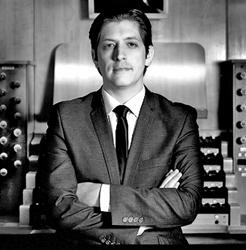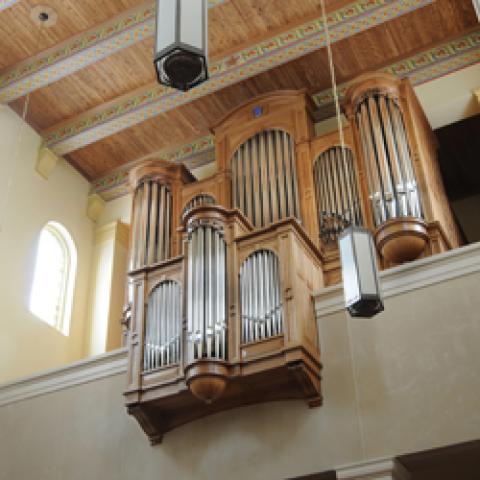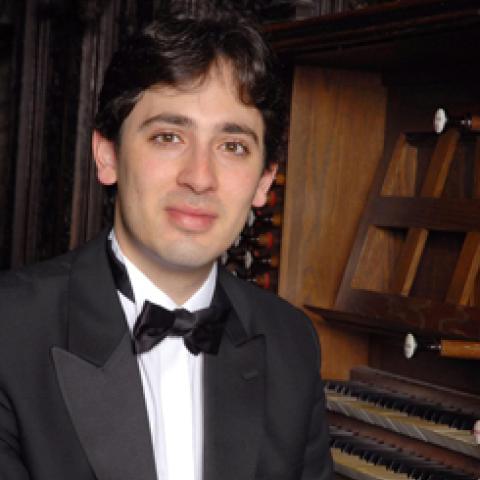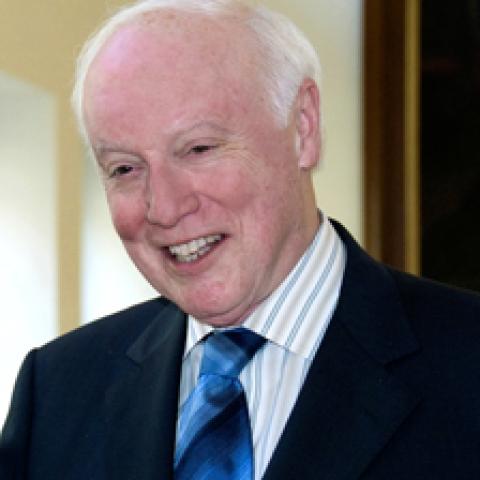Ear-opening . . . challenging . . . and inspiring: these are just a few words to describe the ten courses and eight recitals that comprised last summer’s organ academy in Montréal, presented under the auspices of McGill University. The 2005 event, the fifth to be held biennially since the Academy’s inauguration in 1997, attracted eighty-two regular students and a number of day auditors over the roughly two-week period. As a point of clarification, connoisseurs of pre-romantic-era keyboard music should look beyond the word organ in the Academy’s name: courses and recitals took advantage of not only McGill’s French Classical-style organ and seven of the more centrally located of Montréal’s many excellent organs located in churches, but also the university’s harpsichords, and its 2005 fortepiano by the Belgian builder Chris Maen.
Artistic director John Grew had once again assembled almost a dozen performer-scholars, all at the forefront of their fields, to teach and give recitals. The prominent organist, composer and musicologist Guy Bovet (Musikhochschule of Basel, Switzerland) joined the Academy’s faculty for the first time to teach the course on early Spanish music. McGill musicologist and fortepianist Tom Beghin, representing a new generation of interpreters of classical and early classical era keyboard music, attracted a group of both experienced and aspiring students of the early piano. Courses in improvisation this year were led by two more faculty members new to the McGill Summer Academy: William Porter (Eastman School of Music and McGill University) and Thierry Escaich (Conservatoire national supérieur de Paris). Two other new (or largely new) classes had been planned—in 19th- and 20th-century English organ music, and in 20th-century Canadian and American organ music—but these, unfortunately, were cancelled due to insufficient advance registration.
Many faculty members from past years returned in 2005. The long-celebrated Marie-Claire Alain (Conservatoire National de Région in Paris) presented an overview of the various genres of J. S. Bach’s organ music. John Grew offered his course on French Classical organ music. James David Christie (College of the Holy Cross in Worcester, Massachusetts and Oberlin College Conservatory) was back to teach the course on 17th-century North German music, and Oliver Latry (Conservatoire national supérieur de Paris) again attracted a large following for a course on French organ music from the first few decades of the twentieth century. As in 2003, Hank Knox (McGill University) and Patrick Wedd (Christ Church Anglican Cathedral, Montréal) taught two of the skills that tend to be neglected in one-on-one university organ instruction: continuo playing and service playing, respectively.
Students included both active participants (who were afforded practice time on the instruments) and auditors. Each course convened in a two-hour session, four times a week, in one of three time-slots. A typical active participant, during either or both of the two weeks, came prepared to perform in one course, leaving time to audit a course in another slot and to schedule practice time in the third slot. (A pure auditor could take three classes, one in each of the three slots, if prepared to do all the necessary bus and subway travel from point to point.) As might be expected, courses incorporated informal lectures, a masterclass approach aimed at illustrating interpretive and technical points for all of the participants and auditors, and opportunity for questions and answers.
The eight evening recitals were performed by the Academy’s faculty members to large and enthusiastic crowds. The standard was so uniformly high that it would be impossible to pinpoint one or the other recitalist as having been an audience favorite. Academy students were afforded plenty of opportunity for spontaneous discussion with faculty over food and drink, the option of a field trip to hear selected organs of interest just outside Montréal, and an invitation to attend an ecumenical worship service at Christ Church Anglican Cathedral on Sunday morning.
This writer heard all of the recitals and audited some of the courses, attending all eight of Grew’s classes, seven taught by Latry, three by Wedd, two by Alain, and one by Bovet. Some common themes espoused by these instructors included:
• Thinking beyond the published score—immersion in period treatises, manuscripts, early editions, composer biographies and recommended literature on performance practice.
• Educating one’s auditory imagination in the sound-world of the composer or style period, as the means for judging—moment-to-moment touch, when to articulate and when to simply “think” phrase endings, the length of silence between sections, and ultimately, how to “play the room.”
• Advantages afforded by familiarity with works for other mediums that are contemporary with the keyboard repertoire at hand, and of having experience in performing period music in collaboration with singers and other instrumentalists.
• Experience in discerning in what repertoires, and at what moments, to pursue a literal application of directions in the score and when and how to add and subtract from these for the sake of a stylistically satisfying interpretation.
• The musician as someone broadly knowledgeable in a variety of the arts.
Week 1 of John Grew’s course was organized as a survey of the fundamental principles of playing organ music of the French Classical school. Participants began by performing prescribed movements from the organ suites of Louis-Nicolas Clérambault and continued with their choices of movements by François Couperin. Week 2 progressed back in time through de Grigny, D’Anglebert and Boyvin. Aiming that participants both capture the sound in their ears and understand the underlying principles, Professor Grew emphasized elegant articulation, natural-sounding ornamentation, expressive phrasing, and notes inégales that make the music “swing.” A true master pedagogue—recipient of his Faculty of Music’s Performance Teaching Award in 2005—Grew patiently reinforced each concept with repetition and a variety of teaching methods. In his lectures he simplified our understandings of fingering practice and notes inégales, but without over-simplifying. He handed out copies of tables of ornaments and lists of terms for registration and genres. Through example and counterexample he guided and corrected players’ ears, hands and feet. He allowed time for us to troop down to hear alternative registrations from the hall as well as from the organ gallery. Amidst listing corrections to editorial blunders in the available modern editions, Grew alerted us to the planned release in 2006 of a new scholarly edition of the Livre d’orgue of Nicolas de Grigny (L’Oiseau Lyre, ed. Kenneth Gilbert).
Guy Bovet brought to his course the fruits of his own intensive research. During Week 1 of Siglo de Oro español (“Century of Spanish Gold”), participants performed selections from the tientos and variation sets of sixteenth- to seventeenth-century Spanish composers Antonio de Cabezón, Sebastián Aguilera de Herédia, Juan Cabanilles and Pablo Bruna, and the seventeenth-century Portuguese composer Pedro de Araújo. Professor Bovet advised on ornamentation, tasteful use of diminutions, registration for the divided and undivided keyboard, and metric proportions. In contrast to the gently balanced finger action cultivated for French Classical music, in the Spanish organ music class the pipes of the Guibault-Thérien organ at St-Léon-de-Westmount (built 1995) were activated by high, strong finger strokes. Week 2 of this course focused on the 1626 Facultad Orgánica by Francisco Correa de Arauxo, a treatise on organ playing and ornamentation that contains 69 pieces (mostly tientos) of varying difficulty. Bovet’s own edition is to be published by Ut Orpheus in Bologna in the summer of 2006. For this year’s class, he dictated corrections to the Unión Musical Española edition, spontaneously translated Correa’s explanatory preface to each piece that was played by students, and followed the facsimile of the original tablature during their performances.
Guy Bovet’s recital, on the famous 1960 von Beckerath organ of St. Joseph’s Oratory, juxtaposed the unusual with the unexpected. We heard a Batalha from around 1700 and two Tientos by Correa, followed by the recitalist’s own transcription of a Concerto in A minor by Vivaldi. Next came an Elevation and a Polonaise by Antonio Diana (an Italian composer, fl. 1860s, whose works Lefébure-Wély admired). The intermission preceded two more popularly styled nineteenth-century pieces—Prélude en sol mineur and a Benedictus—both by C. V. Alkan. Bovet’s admittedly light, but nonetheless historically fascinating, program concluded with three of his daring Tangos ecclésiastiques (2000).
Olivier Latry lent his brilliance and energy to the very first recital of the 2005 Academy, a program of twentieth-century French organ music performed on the electropneumatic-action organ of Église du Très-Saint-Nom-de-Jésus (Casavant 1914, 1999). Part I of the recital opened gently with Dupré’s Cortège et litanie and a quiet work by Litaize (Lied), followed by music of Langlais (Thème et variations), Jehan Alain (Aria) and Messiaen (Les Anges and Dieu parmi nous). Part II maintained a fiery mood throughout with an impressive, though perhaps over-long, piece by Messiaen student Jean-Pierre Leguay entitled Péan IV (Création), Deux poèmes (Eaux natales and Vers l’espérance) by Thierry Escaich, and, finally, a stunning improvisation that fully exploited the 91-stop organ.
Latry’s class, entitled “Dupré and His Students,” began at Église St-Jean-Baptiste but, due to sudden malfunction of this instrument, soon moved to Très-Saint-Nom. Week 1 was fashioned around selected works by Marcel Dupré (B-major and G-minor Preludes and Fugues from Op. 7; Variations on a Noël), and works that students had elected to play by Gaston Litaize (Lied and Scherzo from Douze Pièces), Jean Langlais (Te Deum) and Jehan Alain (Aria, Variations sur un Thème de Clément Jannequin, 2e Fantaisie, Deux Danses à Agni Yavishta, Litanies). Week 2 surveyed the organ works of Olivier Messiaen written through 1935.
The course title, “Dupré and His Students,” encapsulated a curious contradiction, evident on two counts. To begin, Marcel Dupré would have been the first to declare that he had no students, certainly not among the generation of organists who, like Langlais, Messiaen, Litaize, and Alain, earned their prizes in organ and improvisation at the Paris Conservatory in the 1930s. As Latry pointed out in his opening remarks, despite the many famous names on Dupré’s class rosters during the second quarter of the twentieth century, none of those whose compositions and performances are best remembered by posterity ever credited their musical formation or consummation to him. Reflecting an apparent personal ambivalence toward Dupré’s role in twentieth-century French organ music, Latry emphasized that other French organ teachers of the time, particularly his own master, Gaston Litaize, were highly critical of Dupré’s interpretations of the organ literature, his pedagogy, and the retrospective state of organ requirements and exams that remained in place at the Paris Conservatory during his tenure.
Second, the phrase “Dupré and His Students” implies a legacy handed down from teacher to students, or, at the very least, a significant compositional link. Nevertheless, Latry’s only mention of a connection between the organ works of the other composers considered in the course and those of Dupré was confined to a small matter sometimes neglected by class participants in their performances: tying of the note commune between voices (whether indicated or implied in the scores of these composers), which Dupré made a rule for all style periods in his pedagogy. No mention was made of the truly significant way in which he had influenced the younger composers—through his pioneering demonstration of musically imaginative virtuoso writing for the organ. It is worth mentioning that Dupré’s first three Preludes and Fugues for organ (composed c. 1911 and published in 1920 as his Opus 7) were so innovative in the second decade of the twentieth century as to be deemed unplayable, except by the composer for whose hands and feet they were written.1 During the 1920s, though, these works passed into the repertoire of Dupré’s younger colleagues, thereby “raising the bar” of French organ technique generally.2 From among the pieces played by class participants, Litaize’s Scherzo (written between 1930 and 1937), Langlais’s Te Deum (1933/34), and Litanies by Alain (1937) show the influence of early Dupré in their combination of bravura with musical depth. Similarly, had it not been for the sonorities of Dupré’s organ compositions prior to 1929, Messiaen could not have left us such works as his Diptyque (composed in 1929), Dieu parmi nous (1935), and Transports de joie (1936).3 For that matter, neither Jeanne Demessieux (1921–68) nor Pierre Cochereau (1924–84) would have improvised with such dexterity already in the 1940s had it not been for Dupré’s example. It was, therefore, mildly ironic that, while guiding a participant in an interpretation of Dupré’s 1922 Variations on a Noël, Latry advised, “Variation 5 should sound like a Cochereau improvisation” and commented that the last chord of Variation 7 is a “Cochereauesque touch.”
In contrast to the oblique manner in which he approached the works of Dupré, Latry was entirely at one with the remainder of the course repertoire. Latry originally learned the Litaize pieces under the composer, and has closely studied the backgrounds to Alain’s organ works. He recalled for us advice he had received directly from Messiaen, and shared interpretive ideas based upon his close study of Messiaen’s own, multiple performing copies of all his organ compositions. A fascinating teacher of interpretation, Latry lent his tremendous musical imagination to devising vivid metaphors for difficult-to-interpret passages that transformed good performances into eloquent ones.
Patrick Wedd brought historical acumen and intensive experience as an accompanist, composer, conductor and church musician to the course on service playing, taught using the four-manual, 50-stop Casavant organ at Ascension of Our Lord Church. Students learned how to adapt their instrument and diversify their technique to the requirements of congregational hymns and psalms on the one hand, and the repertoire for choir and organ—both small and large-scale works—on the other. Countering dogma and unreflective habit, Wedd demonstrated that there is a time and place in organ accompaniment for appropriate and varied degrees of detached playing that project the meter (for instance, in an organ transcription of the viol accompaniment for Gibbons’s “This is the record of John”), and a time and a place to “glue your fingers to the keyboard” (as in “My Eyes for Beauty Pine” by Howells). Students who played anthem accompaniments from English repertoire of the first half of the twentieth century were coached on executing crescendos and decrescendos by means of the swell pedal, and gradually adding or subtracting stops in imperceptible fashion.
Participants in the Bach course performed on the two-manual, 33-stop Karl Wilhelm organ at Saint Matthias Church. In lecture and masterclass modes, Marie-Claire Alain’s approach was a synthesis of ideas gained during what must be almost 70 years of work on Bach’s music. She dwelt on both the music’s contents (“You have to have written fugues yourself in order to play Bach’s fugues”) and contexts (“Play Leipzig organs in order to discover the variety in plenum registrations that work for Bach’s music”). At the close of the course, Alain commended her thorough-going process of study to the class by explaining why she has recorded the complete organ works of Bach so many times: she did so at more than one stage of the early-music movement, as a result of more opportunities to play historic organs and study Lutheran theology, and because every time she practices she “improves.”
During week 1 Marie-Claire Alain played an all-Bach program on the 78-stop organ of St. Joseph’s Oratory to an almost capacity audience. The spiritual and biographical facets of her study of Bach’s music were reflected in the construction of her program. Between large-scale works that acted like sonic pillars, Alain grouped together similar, small pieces in Bach-like, compendium fashion—for example, three successive settings of Allein Gott in der Höh sei Ehr, BWV 662, 663 and 664. A set of five extracts from The Art of Fugue culminated in the abrupt trailing off of an unfinished Fuga à 3 soggetti (Contrapunctus 19), which Alain followed by a pause and then the chorale setting traditionally associated with Bach’s deathbed, Vor deinen Thron tret’ ich, BWV 668.
James David Christie taught and performed on the 38-stop von Beckerath organ of Église de l’Immaculée-Conception. His recital began with works by Buxtehude, Johann Christoph Bach and J. S. Bach. Following the intermission, Christie featured Miracles for Flute and Organ (1978) by Daniel Pinkham (b. 1923), assisted by flutist Denis Bluteau and narrator Louis Cyr. Pinkham, the composer of a significant body of music for organ solo and for organ with other instruments, was present to acknowledge the audience’s warm applause for these five inspirational pieces. No. 2, “The Miracle on the Lake,” which alludes to St. Luke’s telling of the story in which Jesus is called upon to quell a frightening windstorm on the Sea of Galilee, demonstrated that “storm music” for organ need not be gratuitous and can even be appropriate in a spiritual context.
A 17th- to 18th-century British-inspired organ (by Hellmuth Wolff, including some stops preserved from previous organs by Warren and Casavant and other stops after Dom Bédos) at Saint John the Evangelist Church was the scene of William Porter’s intermediate-level class in improvisational forms based on a cantus firmus. In recital on the same organ, Porter played works of Buxtehude, Johann Ludwig Krebs, Ermend Bonnal (La Vallée de Béhorléguy, au matin from Paysages Euskariens) and Bach. He improvised a flawless set of variations on a pair of submitted hymn tunes and, after the Bonnal, an extended fantasy on a given chromatic theme. As encore, he executed an apparently spontaneous chorale prelude in the style of Krebs, the composer with whose works he had begun the recital.
In contrast to the large, or very large, ecclesiastical settings of six of the organ recitals, McGill University’s Redpath Hall was the venue for two evenings of two half-recitals each. These comprised a first half played on an intimate-sounding keyboard instrument and second half played on Redpath Hall’s 1981 Hellmuth Wolff organ. The first such evening opened with harpsichord works by Sweelinck and Frescobaldi performed by Hank Knox. Knox’s performances were vibrant with energy; the closing “Partite cento sopra il Passachagli” from Frescobaldi’s Il primo libro de Toccate was downright sensual. John Grew then performed some rarely played but excellent organ music by Louis Couperin and Henri Dumont, and finished the evening with two favorite movements from François Couperin’s Messe pour les Paroisses. The first half of a parallel recital in Week 2 featured two sonatas by Haydn, Hob. XVI:34 and 39, and Mozart’s Adagio in B minor, K 540, all superbly played by Tom Beghin on a Chris Maen fortepiano modeled after an instrument of Anton Walter (fl. in Vienna 1780–1825). Just as expertly, but in an utter contrast of musical sensibilities, Patrick Wedd then played a half-recital consisting of Lionel Rogg’s Livre d’orgue, Ardennes by Montréal composer Bruce Mather (written for the Redpath Hall instrument) and, true to his Anglophile background, a Prelude and Fugue (Alkmaar) by Arthur Wills.
Thierry Escaich loomed large at the 2005 McGill Academy in his roles as instructor of improvisation in large-scale forms, performer, and composer. His performing career, with its emphasis on the Romantic, symphonic and contemporary repertoires, and his compositions for numerous media have won for him several prizes in France and beyond. Escaich’s thrilling, closing recital at Église du Très-Saint-Nom-de-Jesus wove together all three strands of expertise. From the symphonic repertoire we heard Le Monde dans l’attente du Sauveur by Dupré, Alleluias sereins from L’Ascension by Messiaen, and Duruflé’s Toccata, Op. 5. The improvisation in Part I of the recital, “prélude and fugue” en style romantique, made one wonder if Schumann, Saint-Saëns or Franck ever aspired to extemporize in so vast a symphonic vein. Surpassing even this, Escaich’s Improvisation sur 2 thèmes donnés at the end of Part II was both monumental and technically mind-boggling: at the climax, glissando-like, two-handed scales, ascending and descending several times through the entire length of a keyboard, required his torso to tilt rapidly from side to side. From the recitalist’s composed works, we were treated to a paraphrase on one of the Ave Maris Stella chants (entitled Récit) and three Esquisses pour orgue. Both idiomatic to the organ and sonorously inventive, these pieces attested to the fact that the organ is an eminently viable compositional medium at the turn of the twenty-first century.
The Saturday excursion focused on organ-building, past and present. Our first two stops were to hear small historic organs: one from 1898 by Eusèbe Brodeur in the town of Les Cèdres, the other from 1871 by Louis Mitchell in Vaudreuil. The last stop was at the shop of Juget-Sinclair in the town of Lachine, where we were saw the tools of the craft and examined an organ being built for Wellesley, Massachusetts.
Our longest visit that Saturday was to Lachine’s Église Saint-Anges-Gardiens Church, where Casavant Frères was renovating and rebuilding one of their instruments from 1920. Church, community and government supporters of the renovation project celebrated our presence among them with welcoming speeches, a mini-recital and a superb lunch. Following lunch, Jacquelin Rochette of Casavant Frères delivered a presentation on the Saint-Anges-Gardiens project and showed slides of a new organ in progress for the Brick Presbyterian Church in New York.
A set of controversial points for discussion raised by Guy Bovet, during an impromptu response to Mr. Rochette’s presentation in Lachine, drew attention to something that was missing from the 2005 event as a whole: panel discussion. Constrained as he was by time, Rochette was able to reply to just one of Bovet’s points. Students concentrated intensely during this exchange. Their scattered discussions as they reboarded the bus suggested that opportunities to hear experts with different viewpoints talking about an issue amenable to panel discussion, with time for students’ questions, would be welcome another year. Clearly, though, such an activity would be a challenge to moderate.
In conclusion, participating Montréal and area churches, with their organists, are owed a debt of thanks. Above all, executive director Debbie Giesbrecht (borrowed from the Calgary Organ Festival) and artistic director John Grew are to be highly commended for organizing such an artistically satisfying event.





